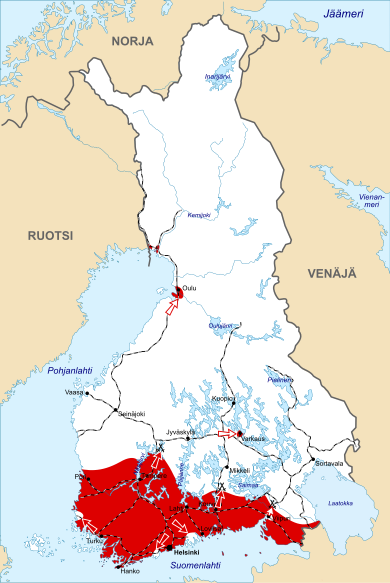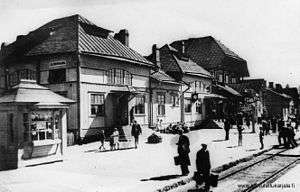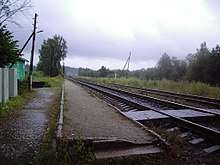Vyborg–Joensuu railroad
The old Karelian railroad (Finnish: Karjalan rata) between Viipuri (Viborg) and Joensuu is a 1,524 mm (5 ft) broad gauge line that used to link Joensuu, Sortavala, Hiitola, Antrea (now Kamennogorsk), and Viipuri (Vyborg). Originally built in 1892-1894 by Finnish State Railways in the Grand Duchy of Finland, in the 1940s most of the railway up to Niirala was ceded by Finland to the Soviet Union in the Moscow Peace Treaty, Moscow Armistice and Paris Peace Treaty as a result of the Winter War and Continuation War. Now the track is located in Leningrad Oblast (Karelian Isthmus), Republic of Karelia and North Karelia. The Sortavala–Joensuu link across the border was abolished after the Continuation War, but was since restored and is currently in use for cargo traffic.

Vyborg–Joensuu line | |||||||||||||||||||||||||||||||||||||||||||||||||||||||||||||||||||||||||||||||||||||||||||||||||||||||||||||||||||||||||||||||||||||||||||||||||||||||||||||||||||||||||||||||||||||||||||||||||||||||||||||||||||||||||||||||||||||||||||||||||||||||||||||||||
|---|---|---|---|---|---|---|---|---|---|---|---|---|---|---|---|---|---|---|---|---|---|---|---|---|---|---|---|---|---|---|---|---|---|---|---|---|---|---|---|---|---|---|---|---|---|---|---|---|---|---|---|---|---|---|---|---|---|---|---|---|---|---|---|---|---|---|---|---|---|---|---|---|---|---|---|---|---|---|---|---|---|---|---|---|---|---|---|---|---|---|---|---|---|---|---|---|---|---|---|---|---|---|---|---|---|---|---|---|---|---|---|---|---|---|---|---|---|---|---|---|---|---|---|---|---|---|---|---|---|---|---|---|---|---|---|---|---|---|---|---|---|---|---|---|---|---|---|---|---|---|---|---|---|---|---|---|---|---|---|---|---|---|---|---|---|---|---|---|---|---|---|---|---|---|---|---|---|---|---|---|---|---|---|---|---|---|---|---|---|---|---|---|---|---|---|---|---|---|---|---|---|---|---|---|---|---|---|---|---|---|---|---|---|---|---|---|---|---|---|---|---|---|---|---|---|---|---|---|---|---|---|---|---|---|---|---|---|---|---|---|---|---|---|---|---|---|---|---|---|---|---|---|---|---|---|---|---|
| |||||||||||||||||||||||||||||||||||||||||||||||||||||||||||||||||||||||||||||||||||||||||||||||||||||||||||||||||||||||||||||||||||||||||||||||||||||||||||||||||||||||||||||||||||||||||||||||||||||||||||||||||||||||||||||||||||||||||||||||||||||||||||||||||
History

The decision to build a 311-kilometre (193 mi) railway from Viipuri (Viborg) to Joensuu was made by the Diet of Finland in 1888. Work on the railroad started in 1890, immediately after the Savonia railroad was finished.
The track from Viipuri, (now Vyborg), via Antrea (now Kamennogorsk) to Vuoksenniska (79 km (49 mi)) was completed in November 1892, Antrea to Sortavala (139 km (86 mi)) in November 1893, and Sortavala to Joensuu (132 km (82 mi)) in October 1894. Six thousand men worked on the railroad at the height of construction in September 1892.[1]
A direct link between Hiitola and Finland Station in Saint Petersburg, Russia, was opened in 1917, bypassing the Riihimäki-Saint Petersburg railroad (see Saint Petersburg-Hiitola railroad).
The bombing of the Elisenvaara station of the Karelian railroad on 20 June 1944, during the final stages of the Continuation War, was the most fatal bombing in Finnish history; over one hundred civilians were killed when bombs hit a train of Karelian evacuees.[2]
After the Winter War and Continuation War Karelian Isthmus and Ladoga Karelia with Viipuri/Viborg, Hiitola, Elisenvaara and Sortavala (Serdopol) were ceded to the Soviet Union, and most stations of the line got to the Soviet side of the new border. In the Moscow Peace Treaty on March 12, 1940, Finland lost the section Viipuri–Antrea–Hiitola–Jaakkima–Sortavala–Matkaselkä–Värtsilä (240 km (150 mi)) to the Soviet Union. Only the Joensuu–Niirala section (71 km (44 mi)) remained in Finland.
Finland built a new railroad on the Finnish side of the new border in the early 1950s, connecting Imatra with the northern part of the Karelian railroad at Säkäniemi (now Parikkala).
Branches

- The Vyborg railway station also serves a number of other railroads.
- At Antrea a 39-kilometre (24 mi) railway to Vuoksenniska branches off from this line. After 1940 and 1944 the Antrea–Enso section (26 km (16 mi)) was ceded to Soviet Union. As of 2007, projects are being discussed to construct a freight railway along the northern shore of the Vuoksi River linking Kamennogorsk (Antrea) to the Losevo station of the Saint Petersburg–Hiitola railroad in order to ship Russian crude oil to the sea port of Primorsk (Koivisto) bypassing the St. Petersburg–Vyborg line.
- At Hiitola (kilometre 93) the Karelian railway merges with the Saint Petersburg-Hiitola railroad.
- The Elisenvaara station was linked to Savonlinna and ultimately Vaasa in Finland. The track meets the new Karelian railroad in Parikkala, on the Finnish side of the border, but the line is closed for traffic and the tracks have been removed in Finnish side to the border. On the Russian side the line 13 kilometres (8.1 mi) from Elisenvaara to Syväoro still exists; and Sorjo station – 7 kilometres (4.3 mi) from Elisenvaara – serves as a local border guard station.
- The Simpele–Elisenvaara section (22 km (14 mi)) of the Vuoksenniska–Elisenvaara line was lifted after 1944. This section is used as a local road. It had stations and stops at Simpele (km 100), Koitsansalo halt (km 108), Lamminsalo (now Ketrovaara) (km 111), Haapavaara halt (km 114), and Elisenvaara (km 122). Recently, reconstruction and reopening of the Elisenvaara–Sortavala–Matkaselkä–Suoyarvi–Tomitsy section was proposed, including electrification at 25 kV 50 Hz AC and track doubling, to connect Imatra and Petrozavodsk.
- There is an 11-kilometre (6.8 mi)-long industrial railroad, completed in 1911, branching off at Lahdenpohja from the Karelian railroad to the shore of Lake Ladoga.
- In 1921 a 139-kilometre (86 mi) railroad linking Matkaselkä (km 215) to Naistenjärvi (Naystenyarvi) was built, which was later in turn linked to Pitkäranta, Kostomuksha and Petrozavodsk.
- In the Finnish part of the railroad there is a Säkäniemi (now Parikkala)–Imatra–Kouvola connection using the new Karelian railroad along the border.
Trains
In Russia the railroad is used to ship petroleum to the ports of the Gulf of Finland as well as lumber and iron ore pellets from Karelia.
Passenger trains
| Route | Time | Notes |
|---|---|---|
| Vyborg–Kamennogorsk | 1:20 | |
| Vyborg–Kamennogorsk–Svetogorsk | 1:35 | |
| Vyborg–Hiitola | 3:00 | |
| Sortavala–Hiitola–Kuznecnoye | 2:20 | Sortavala to Hiitola |
| St. Petersburg (Ladozhsky Rail Terminal)–Hiitola–Sortavala–Kostomuksha | 2:45 | Hiitola to Sortavala |
Note: Times, as of 2007, are with all stops and are approximate.
See also
- Saint Petersburg-Hiitola railroad
References
- Jaakkiman rautatieasema - helmi kulkijan silmälle Archived 2005-05-08 at the Wayback Machine (in Finnish)
- Vaiettu murhenäytelmä Archived 2007-03-08 at the Wayback Machine - YLE (in Finnish)
External links
- The Finnish Historical Newspaper Library 1771-1890 - Karjalan rautatie at article index (in Finnish and Swedish)
- VR 1862–1937, and VR 1862–1962 (official histories)